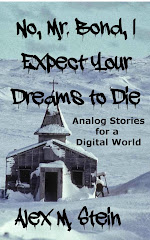Great songs fill the room. Their presence is a palpable force, charging the air molecules. When the great songs end, their sonic properties linger. Maybe you can't hear them anymore, but you can sense them in the air and it takes a while for that sense to dissipate.
One such song is "I Still Want You" by the Del Fuegos, from their 1985 album Boston, Mass. It's a great song about loss, love, and longing, which perfectly captures a mixture of promise, sadness, and regret in one amazing line:
The car we bought together just started to rustIf you grew up in the Northeast, where they over-salt roads in winter and the salt eventually eats through your car (especially if it's the type of old beater you and your girlfriend would buy), this might be the second saddest thing in the world. (The saddest is Dan Zane's voice and the certainty that, even though he might still want her, she's gone for good.)
When I split up with my girlfriend (with whom I moved from Boston to California), I thought a lot about three things: 1) the Del Fuegos, 2)how I drove the first car I ever owned (a '73 VW Beetle) through a snowstorm until six inches of snow came up under the floor mats through a rusted out hole in the floor, and 3) how no one in Los Angeles understands cars rusting (let along how sad that can make you feel). Relationships, like songs, linger in the air after they're finished.
In the mid-80s, there was a roots music boomlet (led by the Blasters, the Bodeans, Georgia Satellites, Lone Justice, and Los Lobos). The Del Fuegos (Dan Zanes, his brother Warren Zanes, Tom Lloyd, and Woody Giessmann) had a blend of bluesy garage rock that won them tons of fans -- first in Boston and then throughout the Northeast -- and got them got signed to Sire Records at the tail end of that boomlet. The band made three records with soon-to-be-superstar-producer Mitchell Froom (who later worked with Crowded House, Richard Thompson, Elvis Costello, Suzanne Vega, Bonnie Raitt, Randy Newman, Paul McCartney, Los Lobos, and many others). They were poised to break big nationally, following the route paved by Bruce Springsteen. And there's an alternate universe out there somewhere where the Del Fuegos became as big as U2 (and together they short-circuited the whole boy-band movement of the 1990s).
But not in this universe.
Here, they were one of several local bands featured in a strange series of Miller Beer commercials (Youtube link) where they claimed that rock 'n' roll is "folk music… pretty much, but, you know, that's cuz it's for folks."
Then they moved to L.A., hired hair stylists, horns, and chick singers. Half the band quit when the third album flopped. They changed labels and producers and made a fourth album that felt generic and tired. By the early 1990s, the band was done. Warren Zanes went back to school, became VP of Education at the Rock 'N' Roll Hall of fame (and eventually released a solo album in 2002). Dan Zanes made a few solo albums, got married, moved to Brooklyn, and eventually became a superstar. Making kids music. My nephew (who's 4) is a huge fan.
Talk about an alternate universe.
 Late 1983 found me in New York with my friend Ed (whose record collection is still spoken of by his friends with a mixture of reverence and jealousy). We wandered into the Tower Records in the Village (which took up an entire square block of prime real estate, boasted the finest selection of British and European new wave bands in the U.S., and was more Temple than store). I remember it was cold and snowy outside and warm and inviting indoors (but maybe my memory is playing tricks on me). Did I spend days there or did it just feel that way? Did I really explore every part of the store except Opera and Country? Did I literally rappel down the wall in the Classical section? I can't quite remember.
Late 1983 found me in New York with my friend Ed (whose record collection is still spoken of by his friends with a mixture of reverence and jealousy). We wandered into the Tower Records in the Village (which took up an entire square block of prime real estate, boasted the finest selection of British and European new wave bands in the U.S., and was more Temple than store). I remember it was cold and snowy outside and warm and inviting indoors (but maybe my memory is playing tricks on me). Did I spend days there or did it just feel that way? Did I really explore every part of the store except Opera and Country? Did I literally rappel down the wall in the Classical section? I can't quite remember.

 Back in the early days of Rock 'n' Roll, Phil Spector was hailed as a genius who built a dense "wall of sound" by multitracking dozens of instruments and backing vocalists (and mixing it all down to mono).
Back in the early days of Rock 'n' Roll, Phil Spector was hailed as a genius who built a dense "wall of sound" by multitracking dozens of instruments and backing vocalists (and mixing it all down to mono).






